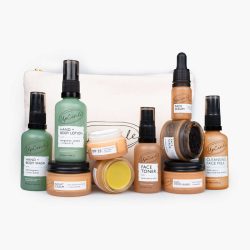Although we may keep a zero waste behavior throughout the year, when we arrive at a new destination, things tend to get a bit complicated. How to plan an eco-friendly trip? In this article, you’ll find tips to travel sustainably 😀
The beach is the perfect example. We have all been to a beach and see with our own eyes the pollution that humans produce. It is believed that much of the plastic pollution in coastal areas is linked to the fact that 80% of tourism goes to these hot regions to relax.
In fact, it was detected that during the peak tourist season, marine litter in the Mediterranean area increased by 40%. The problem is clear: these millions of tons of plastic that are dumped into the ocean directly affect the life of all marine species.

In addition, the large tourist complexes also have their part in this. Being able to cause destruction of natural habitats, soil erosion and drastic increase in water use. Furthermore, all these changes complicate the preservation of species, particularly those in danger of extinction.
On the other hand, the big elephant in the room is air travel. According to The World Counts, tourism contributes to more than 5% of global greenhouse gas emissions, while 90% of it is related to transportation. It is estimated that by 2030 CO2 emissions linked to tourism will increase to 1,998 million tons.
So… How can we enjoy a vacation full of fun and adventure without harming our planet? Here are some recommendations!
.
.
.
1- Choose local destinations
By traveling locally, we minimize our emissions footprint that contributes to climate change. Moreover, it favors the local economy while allowing you to be surprised by discovering different landscapes just around the corner.
In Amsterdam there are eco-friendly hotels that care for the environment! Some of the particularities that make these lodgings awesome are:
- The furniture in the rooms is certified sustainable or made from recycled materials.
- They use renewable energy, such as solar panels.
- Breakfast is 100% organic.
- Water management is smart.
- They use eco-cleaning products.
- They are e-car friendly.
TIP: You can take these points into account to consult before making a reservation in the place of your choice!
In addition, there are hotels like the Jakarta, also in Amsterdam, which are carbon neutral. Its ecological bamboo construction and the water heating system with solar panels are two key concepts of the sustainability of this space.

If you are looking to take a few days off in other destinations within the Netherlands, we recommend the following:
- Giethoorn→ “The Venice of the North” a village that can be explored via bike lanes or canals. Depending on the season it can be explored by boat or ice skating in winter months.

- De Hoge Veluwe National Park→ one of the largest in Holland, rare wildlife, and bikes available for rent.

- Texel Island→ the largest of the West Frisian Islands, with awesome landscapes, sweeping sand dunes, salt marshes filled with lavender and beaches.

- Kinderdijk→ a typical Dutch countryside full of windmills from the 18th century was declared a UNESCO World Heritage Site in 1997.

.
.
.
2- Prepare for outdoor camping
Going camping allows us to be the ones who adapt to the environment. Without altering the natural habitat, if we do it, taking the necessary precautions. Also, it’s a great alternative if you are on a budget.
Here’s a short selection of campsites from this great article published by our friends at Dutch Review:
- Het Veerse Gat, Zeeland→ A great spot for camping in the Netherlands. It’s close to a large forest and the seaside. You can also visit the old cities of Veere and Middleburg.

- Distelheide, Gelderland→This is a perfect place to enjoy a fire at night. You’ll find a variety of landscapes in open nature.

- Dasselaar, Flevoland→ A camp located in Flevoland, that’s a great spot for hikers, cyclists and mountain bikers. You can set your tent in the shade of apple and nut trees.

.
.
.
3- Opt for sustainable transport
As we told you, traveling by plane has a negative impact on our earth’s atmosphere, contributing to the gasses that produce the greenhouse effect. According to WWL, if we continue at this rate, emissions could triple by 2050, the pre-epidemic values.
Traveling in traditional cars is also not convenient since we use non-renewable resources to move a small group of people. However, we do have a few options for you to consider, whenever possible:
- Biking→ For short distances, there are many routes within the Netherlands, but also some international ones. This way of slow travel allows us to travel along routes with beautiful and well-maintained landscapes.
- Trains→ Did you know that the Netherlands are pioneers in the use of wind power to run trains? The entire network works with this renewable energy, which has been gradually incorporated since 2017.
- Bus→ As of the “Zero Emissions Bus” voluntary agreement, all new buses have to use 100% renewable energy. Also, the entire network will have to be clean energy by 2030.
- Electric Car→ If you need to take a trip by car, you can choose to rent an electric car. Or, join shared trips!
.
.
.
4- What to Pack?
Some basic recommendations are:
- Carry the essential minimum, the less load we transport, the less energy the transport uses.
- Pack your eco-friendly products. You can make a list thinking about what you need for your everyday life!
Here are some ideas:
1- Reusable Bottle & Coffee Cup
This is a mega essential that cannot be missing in your bag. If you are going to do physical activity on your trip, make sure it is big enough. Also, you can add reusable cutlery and sorbet to be prepared!

.
2- Zero Waste Bathroom Kit
To be a traveler 2.0! Prepare your travel kit, with solid shampoo, toothpaste tablets and a bamboo toothbrush. You can make sure you don’t leave traces of plastic wherever you go.

.
3- Your backpack choice
Your handbag can be really comfortable, and also sustainable. These cool backpacks from Hemper are made with natural fiber fabrics that minimize the impact on the planet.

Besides! Wherever we are, we have to go shopping, don’t forget to pack your reusable bag.
.
4- Conscious Bathing Suit
It’s possible! The entire line of Save The Wave products is made with ECONYL fabrics, a 100% recycled nylon yarn. There are plenty of models to choose from.

.
5- Eco-friendly sunscreen
This reef-safe from UpCircle is a dermatologically tested mineral sunscreen that provides an essential physical defence against premature ageing caused by the sun. Naturally derived non-nano zinc oxide protects the skin whilst powerful antioxidant raspberry seed oil defends against free radical damage.
Why SPF 25?: There is only 1% difference in UV ray protection between SPF 25 and SPF 30 and another 1% difference between SPF 30 and SPF 50. This means that this SPF 25 blocks 96% of UV rays whereas a SPF 30 blocks 97% – reapplying any SPF regularly is the best way to ensure your skin stays protected!

Stay tuned for more sustainable news!
See you soon 😀
.
.
.
.
.
Photo Sources, in order of appearance:
hoteljakarta.amsterdam/subtropische-tuin/
giethoorn.com/
theculturetrip.com/europe/the-netherlands/articles/the-best-things-to-do-in-the-hoge-veluwe-national-park-the-netherlands/
holland.com/global/tourism/discover-the-netherlands/visit-the-regions/wadden-islands/texel-2.htm
https://es.wikipedia.org/wiki/Molinos_de_viento_de_Kinderdijk
terreinzoeker.natuurkampeerterreinen.nl/terreinen/zeeland/het-veerse-gat/#media
www.logerenbijdeboswachter.nl/kamperen/dasselaar
www.logerenbijdeboswachter.nl/natuurkampeerterreinen/de-dennen







